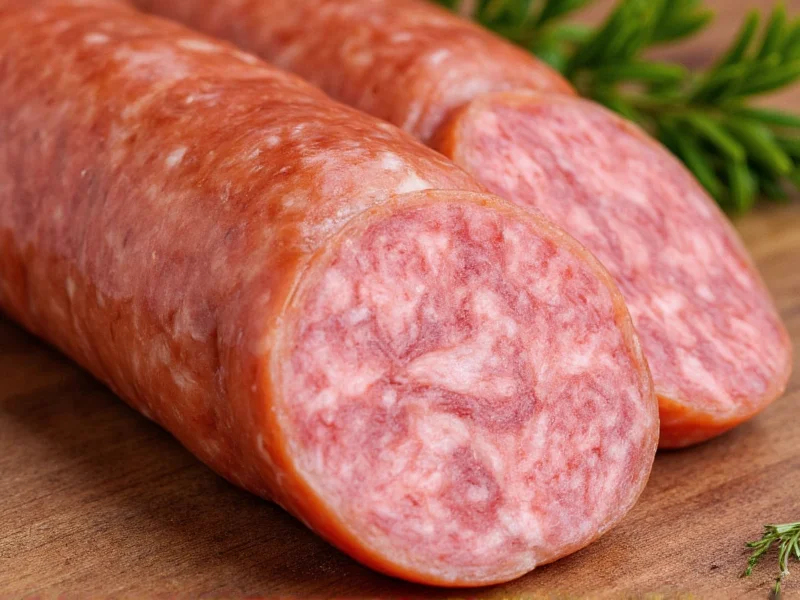Proper sausage storage is critical for food safety and preventing foodborne illness. Understanding exactly how long different sausage varieties remain safe to eat in your refrigerator helps minimize waste while protecting your health. This comprehensive guide provides science-based storage timelines backed by food safety research.
Understanding Sausage Shelf Life in Refrigeration
Sausage longevity depends on multiple factors including preparation method, ingredients, and storage conditions. The USDA recommends keeping your refrigerator at 40°F (4°C) or below for optimal food safety. At this temperature, bacterial growth slows significantly but doesn't stop completely.
Sausage Types and Their Refrigerator Lifespan
Different sausage varieties have distinct shelf lives due to variations in processing, moisture content, and preservatives. Here's a detailed breakdown of how long various sausages remain safe in the refrigerator:
| Sausage Type | Unopened (Days) | After Opening (Days) | Cooked (Days) |
|---|---|---|---|
| Raw pork/beef sausage | 1-2 | 1-2 | 3-4 |
| Raw chicken/turkey sausage | 1 | 1 | 3-4 |
| Smoked sausage (kielbasa) | 7 | 7 | 7 |
| Hard dry sausage (salami) | Indefinite* | 3 weeks | N/A |
| Cooked breakfast sausage | N/A | N/A | 3-4 |
*Hard dry sausages remain safe indefinitely in the refrigerator but experience quality degradation over time. For best flavor and texture, consume within 6 weeks.
Key Factors Affecting Sausage Freshness
Several elements influence how long your sausage remains safe to eat:
Refrigerator Temperature Consistency
Maintaining a consistent temperature of 40°F (4°C) or below is crucial. Fluctuations above this threshold accelerate bacterial growth. Use an independent refrigerator thermometer to verify actual temperature, as built-in displays can be inaccurate.
Packaging Integrity
Vacuum-sealed packages preserve sausage longer than permeable casings. Once opened, transfer sausage to airtight containers or wrap tightly in plastic wrap. Exposure to air introduces bacteria and accelerates oxidation.
Ingredient Composition
Sausages with higher fat content spoil faster than lean varieties. Natural preservatives like celery powder or cultured celery juice extend shelf life compared to products relying solely on synthetic nitrates. Organic sausages often have shorter shelf lives due to restricted preservative use.
Proper Sausage Storage Techniques
Follow these evidence-based methods to maximize sausage freshness:
- Store raw sausage on the bottom shelf of your refrigerator to prevent cross-contamination
- Keep sausage in its original packaging until ready to use
- After opening, place sausage in glass containers with tight-fitting lids
- Label containers with purchase and opening dates
- Never place warm sausage directly in the refrigerator - cool to room temperature first
Recognizing Spoiled Sausage: Critical Warning Signs
Before consuming sausage, perform these safety checks:
Visual Indicators of Spoilage
Fresh raw sausage should maintain its original color. Look for:
- Grayish or greenish discoloration
- Visible mold (white, green, or black spots)
- Excessive slime or stickiness on surface
Olfactory Warning Signs
Your nose provides immediate feedback about spoilage:
- Sour or acidic smell instead of meaty aroma
- Ammonia-like odor
- Generally unpleasant or "off" smell
Texture Changes
Properly stored sausage maintains firmness. Warning signs include:
- Excessive softness or mushiness
- Slippery or slimy surface
- Dry, crumbly texture in previously moist sausage
When in doubt about sausage safety, follow the food safety maxim: "When unsure, throw it out." Consuming spoiled sausage risks foodborne illnesses including salmonella, listeria, and E. coli infections.
Extending Sausage Shelf Life Through Freezing
Freezing effectively pauses bacterial growth. For best results:
- Wrap sausage tightly in freezer paper or heavy-duty aluminum foil
- Place wrapped sausage in airtight freezer bags, removing excess air
- Label packages with contents and freezing date
- Store at 0°F (-18°C) or below
Freezer storage timelines:
- Raw sausage: 1-2 months for best quality
- Cooked sausage: 2-3 months
- Smoked sausage: 1-2 months
Thaw frozen sausage in the refrigerator, not at room temperature, to maintain safety. Allow 24 hours for complete thawing of most sausage varieties.
Food Safety Best Practices for Sausage Handling
Implement these professional food handling techniques:
- Wash hands thoroughly before and after handling raw sausage
- Use separate cutting boards for raw meats and ready-to-eat foods
- Cook sausage to an internal temperature of 160°F (71°C)
- Clean all surfaces that contact raw sausage with hot, soapy water
- Never refreeze previously frozen sausage that has been thawed
Practical Sausage Storage Summary
Understanding how long sausage lasts in the refrigerator after opening prevents both food waste and potential illness. While general timelines provide guidance, always prioritize sensory evaluation over calendar dates. When storing uncooked sausage in the fridge, maintain consistent cold temperatures and proper packaging. For those wondering how long does cooked sausage last in the fridge, remember the 3-4 day maximum regardless of appearance. Following these evidence-based practices ensures you enjoy sausage safely while minimizing waste. When considering how long does smoked sausage last in the fridge unopened, the 7-day guideline provides a safe consumption window for most varieties.











 浙公网安备
33010002000092号
浙公网安备
33010002000092号 浙B2-20120091-4
浙B2-20120091-4